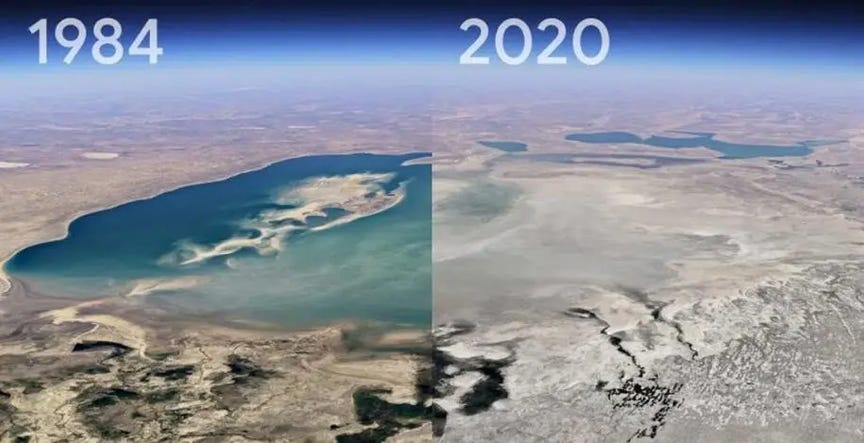Yves here. From the early days of this site, we identified potable water as the first important natural resource that would come under stress. The shortages in the Southwest demonstrate what is set for many places which have long had water supply issues, like Australia.
By Thomas Neuburger. Originally published at God’s Spies
“The crumbling America that they drove across, where Texans were strung up on New Mexico fences as warnings, most definitely wasn’t the America he kept in his head.”
—Paolo Bacigalupi, The Water Knife
From an op-ed in the Palm Springs (CA) Desert Sun:
It’s time for Army Corps of Engineers to investigate the feasibility of moving water West
Numerous letters … have commented recently on the possibility of moving water from the Mississippi River to the Colorado River at Lake Powell (Glen Canyon dam on the Utah/Colorado border) and then downstream to Lake Mead (Hoover Dam/Las Vegas) and on through Arizona and beyond. Some of these letters are supportive and some not. The whole point of suggesting this solution to the Southwest’s water problem is to generate a public demand to the Army Corps of Engineers to investigate the feasibility of such a project.
I suggested diverting 250,000 gallons/second, which is only about 5% of the flow on the lower Mississippi south of the Old River Control Structure (ORCS) in Central Louisiana 300 miles above New Orleans. This water does nothing except flow out into the Gulf of Mexico. It generates no electricity and doesn’t help commercial shipping or recreational boating. It only causes flooding problems in New Orleans. No state above the OCRS would suffer any loss of water.
If 250,000 gals/sec is impractical, have the Corps consider a flow of 125,000 gals/sec (only 2.5% of the downriver flow), which would take two to three years to fill Lakes Powell and Mead. This is a rather rapid and reasonable time frame to solve the water problems of the Southwest.
The writer is a resident whose opinion was boosted to the op-ed section of his local paper. Of course, writers on this subject who live near the Mississippi are resistant (though some agree that the project might reduce Mississippi flooding), and the general response from them is “Hell no.”
I live in the Pacific Northwest. Opinion here, about schemes to take water from the Columbia River to feed the Californias of the world, is also “Hell no.” Everyone I know in Chicago feels the same way about sending Great Lakes water to the drying Southwest. “Hell no,” they say, with almost a single voice.
Of course, there’s more than one problem with schemes to rob water from … somewhere … to make the Southwest viable again. In the case of the Mississippi River scheme, that problem is this, from the same op-ed:
Yes, this would require massive pumping stations to lift the water up the Continental Divide at some point (the lowest lift would be 4,000 feet in Campbell, New Mexico, close to Albuquerque), but then it would be all downhill using gravity to Lake Powell or somewhere else on the Colorado above the Glen Canyon Dam. One writer suggested a series of windmills to generate the electricity, but, of course, you would need holding basins for those times when the wind isn’t blowing. That would be the Corps’ job to figure out exactly how to generate the electricity.
“That would be the Corps’ job” to figure all this out. I don’t know the political affiliation of this Palm Springs resident, but I can guess. He wants to take water from someone else’s river, raise it 4,000 feet, pipe it 1,400 miles away, and use the Army (not taxes) to do the job — all so he can live in a dying desert town for a few more years. Perhaps he’s a government-hater only on weekdays.
The Drying Southwest Desert
Face it — the great American Southwest is in trouble, real trouble. From that same Desert Sun, a summer news report (emphasis added):
Coachella Valley is experiencing one of its hottest summers on record — again. Surprised? Here are the stats
On June 15 and July 10, 2021, the daily maximum temperature records were broken at 120 degrees. Aug. 3 and 4 of that year also saw records fall, with the thermometer hitting 119 and 122, respectively. And on June 17, 2021, Palm Springs hit 123 degrees, tying the record for the hottest day ever.
By the time fall hit, and temperatures dropped back into the double-digits, eight daily maximum temperature records had fallen. This summer, as many other parts of the country experience record-breaking heat, temperatures in the Coachella Valley have yet to hit daily records. Notably, the mercury hasn’t hit 120 degrees. …
[T]he average temperatures in June and July have 2022 on track to be one of the hottest summers recorded in the Coachella Valley. … [W]e’re just 1.5 degrees off the record pace of last year [for average summer temperature].
The Coachella Valley — and indeed, all of the American Southwest — is becoming unlivable:
Climate change is expected to push average high temperatures in the Coachella Valley up by 8 to 14 degrees by the end of this century, according to a state assessment of climate change in the Inland Deserts region.
And the op-ed writer wants to solve the problem by creating a 1,400-mile pipeline over the Rockies so he can continue to live there … instead of, let’s say, moving.
It’s a silly idea, of course, and it won’t happen, just as all the other silly ideas — drain water from the Columbia and send it to the south, drain water from the Great Lakes and send it to west, desalinate the salty blue Pacific — none of these are going to happen.
Which leaves two unappealing choices: The op-ed writer and all his friends can move, destroying whatever towns and cities they’re fleeing; or they can stay put and fight with everyone else in the dying Southwest desert for the last scraps of water left to them. And then they can move.

Paolo Bacigalupi’s prescient novel The Water Knife is about just such a fight:
In Papa’s head, things looked one way, but in Maria’s experience they were nothing the same. He kept saying that this was America and America was all about freedom and doing what you wanted, but the crumbling America that they drove across, where Texans were strung up on New Mexico fences as warnings, most definitely wasn’t the America he kept inside his head.
People who want to leave will get out. People who refuse to leave — or can’t afford to — will fight for survival in the way the Western world has always fought for survival, by destroying everything of anyone else’s they can to keep control of what’s theirs.
You don’t see it now, this fight, so it may be hard to imagine. But look at the changes to Lake Mead below…


…then imagine Lake Mead, a lifeline for water in the West, fed by a dying river, in 15 years.
What will the great and the good, the city fathers and mothers, of Las Vegas, Phoenix, Los Angeles do to survive? Whatever they do — abandon their towns to rot or to those who can’t leave; or stay and battle it out for the myth of more water — whatever they do, the death of the American Southwest will be felt across the country, and in more ways than one.
Take one last look, America, at the place that you are leaving, the land of the City of Angels and the bird that’s reborn in flames. That place will be gone in less than a generation if America’s great and good stay on their current path.


